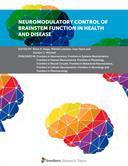Explore

Neuromodulatory Control of Brainstem Function in Health and Disease
0 Ungluers have
Faved this Work
Login to Fave
The brainstem is a conduit connecting higher brain centers, cerebellum and spinal cord and provides the main sensory and motor innervation to the face, head and neck via the cranial nerves. It plays a pivotal role in the regulation of respiration, locomotion, posture, balance, arousal (alertness, awareness and consciousness), sensory information processing (nociception, etc.), autonomic functions (including control of bowel, bladder, blood pressure and heart rate) and is responsible for the regulation of numerous reflexes including swallowing, coughing and vomiting. It is controlled by higher brain centers originating from cortical and subcortical regions including the basal ganglia and diencephalon as well as feedback loops from the cerebellum and spinal cord. A modulatory control of brainstem output can be accomplished by affecting individual neurons and consequently, the operation of neural microcircuits and behavior. This is achieved by altering cellular excitability, synaptic transmission (release probability, postsynaptic receptor responsiveness, thus altering synaptic strength and efficacy) and network properties. Such dynamic control provides flexibility of the nervous system to adapt neural output according to the functional requirements and/or demands of the individual to achieve the desired behavioral state in a changing environment. Neuromodulation can be achieved by the “classical” neurotransmitters glutamate and GABA (gamma-amino butyric acid) by primary excitation and inhibition of the “anatomical network”, but can also be achieved through the use of transmitters acting on G- protein coupled receptors. Such neuromodulators include the monoamines (serotonin, noradrenaline and dopamine), acetylcholine, but also glutamate and GABA. In addition, neuropeptides and purines act as neuromodulators. Other chemical mediators such as nitric oxide and growth factors may also have similar actions. The aim of this Research Topic is to highlight recent advances in our understanding of the intrinsic and extrinsic neuromodulatory systems affecting brainstem function from the anatomical, physiological and pharmacological perspective and to emphasize how these advances strengthen, modify or challenge existing conceptual models of sensorimotor and autonomic control.
This book is included in DOAB.
Why read this book? Have your say.
You must be logged in to comment.
Rights Information
Are you the author or publisher of this work? If so, you can claim it as yours by registering as an Unglue.it rights holder.Downloads
This work has been downloaded 159 times via unglue.it ebook links.
- 55 - mobi (CC BY) at Unglue.it.
- 50 - epub (CC BY) at Unglue.it.
- 54 - pdf (CC BY) at Unglue.it.
Keywords
- Autonomic Function
- Biology, Life Sciences
- brainstem
- Life sciences: general issues
- Locomotion
- Mathematics & science
- movement-related disorders
- Neuromodulation
- Neurosciences
- neurotransmitters and motor control
- Pain
- Science: general issues
- spinal cord injury
- thema EDItEUR::P Mathematics and Science::PD Science: general issues
- thema EDItEUR::P Mathematics and Science::PS Biology, life sciences::PSA Life sciences: general issues::PSAN Neurosciences
Links
DOI: 10.3389/978-2-88963-575-7Editions

